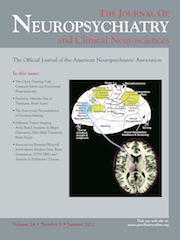A Case of Pisa Syndrome During Sertraline and Quetiapine Treatment
To the Editor: Pisa Syndrome (PS) is a rare occurrence in patients with neurodegenerative disorders, characterized by abnormally sustained posturing, with a flexion of the body and head to one side and a slight axial rotation of the trunk.1 PS has also been observed as a rare adverse drug reaction (ADR) during treatment with typical antipsychotic drugs and in some cases after administration of atypical antipsychotics.2 No cases were reported to occur with sertraline and only one with quetiapine.3 We report a severe case of PS appearing after administration of sertraline and quetiapine, which remitted after sertraline removal.
“Ms. S.M.,” a 47-year-old woman with a severe organic brain disorder, was in therapy with ziprasidone 160 mg/day, valproate sodium 1,500 mg/day, and clonazepam 6 mg/day. Because of the persistence of psychotic symptoms, 800 mg/day quetiapine was administered, and ziprasidone was withdrawn. Because of distal upper limb tremor, the patient received biperiden 4 mg/day. One month later, sertraline was administered, at 200 mg/day because of the worsening of obsessive-compulsive behavior. Five days after the increase in sertraline dosage, the patient experienced severe PS despite the biperiden treatment. On hospitalization, no abnormalities were observed in hematochemical parameters, electrochardiography and urine analyses. Evaluation of extrapyramidal symptoms (EPS), using the Simpson–Angus Scale (SAS),4 yielded a score of 28 (Table 1). Sertraline was discontinued, and quetiapine reduced to 400 mg/day. The other treatments were maintained. The PS significantly declined in 4 days (SAS score: 11), and the patient was discharged. After 15 days the patient was re-evaluated, and the SAS score was 6 (Table 1).
| Day 1 | Day 5 | Day 16 | |
|---|---|---|---|
| Gait | 3 | 1 | 1 |
| Arm-dropping | 2 | 1 | 0 |
| Shoulder-shaking | 4 | 2 | 0 |
| Elbow rigidity | 3 | 1 | 1 |
| Wrist rigidity or fixation of position | 3 | 1 | 0 |
| Leg pendulousness | 4 | 2 | 1 |
| Head-dropping | 2 | 1 | 1 |
| Glabella tap | 3 | 1 | 1 |
| Tremor | 2 | 0 | 0 |
| Salivation | 2 | 1 | 1 |
| Total score | 28 | 11 | 6 |
TABLE 1. Evaluation of Extrapyramidal Symptoms (EPS), Using the Simpson–Angus Scale (SAS)
The Naranjo adverse drug reaction probability scale identified the relationship between the patient’s development of ADR and the drug as “possible.”
This is the first report implicating a role for sertraline in the development of PS. The correlation of sertraline and ADR is supported by the temporal profile, the clinical features, and the complete resolution when sertraline was withdrawn and quetiapine reduced. Although the clinical information does not allow us to determine whether sertraline alone or its association with quetiapine was responsible for the observed ADR, removal of sertraline was sufficient to resolve the ADR. Sertraline can elicit the imbalance between the cholinergic and dopaminergic neurotransmissions that has been described to account for PS, although through mechanisms are different from those of quetiapine. In particular, at therapeutic dosage, selective serotonin reuptake inhibitors inhibit both nigrostriatal and ventral tegmental dopaminergic neurons;5 quetiapine inhibits the dopaminergic system by reducing dopamine D2 receptor-mediated neurotransmission.6
The role of sertraline in inducing PS that we describe here supports the notion that care has to be taken in polytherapy approaches with drugs affecting neurotransmission. It also highlights the possibility that drugs that have a propensity on their own to cause PS may have synergistic effects.
1 : Drug-induced Pisa syndrome (pleurothotonus): epidemiology and management. CNS Drugs 2002; 16:165–174Crossref, Medline, Google Scholar
2 : Pisa syndrome (pleurothotonus): report of a multicenter drug safety surveillance project. J Clin Psychiatry 2000; 61:569–574Crossref, Medline, Google Scholar
3 : Drug-induced Pisa syndrome under quetiapine. Prog Neuropsychopharmacol Biol Psychiatry 2009; 33:1286–1287Crossref, Medline, Google Scholar
4 : Validity of Simpson-Angus Scale (SAS) in a naturalistic schizophrenia population. BMC Neurol 2005; 5:5Crossref, Medline, Google Scholar
5 : Extrapyramidal symptoms with selective serotonin reuptake inhibitors. Br J Psychiatry 1994; 165:728–733Crossref, Medline, Google Scholar
6 . Cholinergic–dopaminergic imbalance in Pisa syndrome. Clin Neuropharmacol 2009; 26:119–121Crossref, Google Scholar



